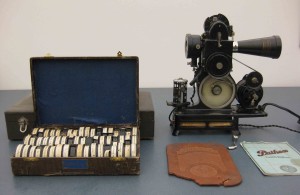
This is the 9.5mm Pathé Baby projector and film (reduction prints).
9.5mm, a safety stock (not flammable) developed for home use, was invented in France in 1922, pre-dating the familiar 16mm gauge by one year. Previously, Pathé had offered a safety stock on 28mm, which proved too expensive to see widespread use. 9.5mm took off, becoming extremely popular in Europe where it is still used to this day by amateur filmmakers. 9.5mm was sold in the USA as well, but 16mm proved to be more commonly used by North Americans, which is why many of us have never heard of 9.5mm film.

As you can see in this image, the 9.5mm gauge features a perforation between the frames instead of along the side (which is the standard for all other film gauges used today). This affords greater real estate for the image, as leaving space along the edge for the perforation is not necessary. This narrow film has the image area almost as big as 16mm.
9.5mm was an early amateur film stock, used by people to make home movies. Pathé initially included instructions and equipment for developing the film at home as well, but difficulty in achieving consistent results led most people to send it away for processing.
The glassed-in circle at the bottom of the projector is an enclosed film take-up area. The projector can play two sizes of film cartridges, lengths of 8.5 meters or 20 meters.

The films in this box are reduction prints of French, English, and American condensed films, sold in France. The projector features a mechanism which stops the film for a few seconds when it is signaled to do so by a notch on the edge of the film. This was employed for commercial films, freezing the film on a title card, saving precious film stock for moving image instead of using it up making longer title cards.
For more information on 9.5mm and the long history of home movie technology, see Alan Kattelle’s exhaustive book on the subject, Home Movies (Nashua: Transition Publishing, 2000.)
